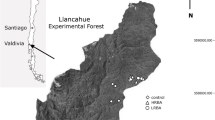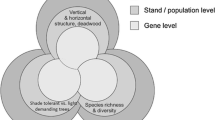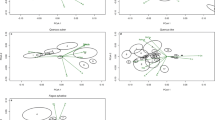Abstract
Timber and biodiversity are considered two antagonistic ecosystem services (ES), largely influenced by silviculture and site ecological conditions. In order to address the trade-offs between these two ES over time, we performed a retrospective study at compartment level in the Pinus sylvestris forests of the Spanish Central Mountain System. Archival data from Management Plans for eight forests with contrasting silvicultural systems (uniform shelterwood system, group shelterwood system, irregular shelterwood system,) and three different site quality classes were analysed. Timber production was assessed through stand volume, harvested timber volume and a stand volume index. Biodiversity was examined through structural diversity (Gini index, Shannon tree size diversity index, Simpson’s reciprocal index and evenness index, all applied to diameter classes) and the abundance of large living trees. For all silvicultural systems investigated, stand volume and harvested timber volume have grown since the beginning of the management plans (beginning of the twentieth century in some forests). The largest yields of timber corresponded to the best quality sites with more intensive silvicultural treatments (uniform and group shelterwood systems). The uniform shelterwood system showed lower figures for structural diversity, though not always significant. The best site qualities maintained notable structural diversity values, even under the most intensive management system. The application of the different management systems over decades has revealed a synergy between timber production and structural diversity, particularly in those systems maintaining more than one age class, although results are conditioned by forest harvesting history. The interaction between historical silvicultural treatment and site quality has been identified as an important source of information to understand forest dynamics and functioning of ES provision.





Similar content being viewed by others
References
AEMET (2011) Atlas Climático Ibérico. Temperatura del aire y precipitación (1971–2000). AEMET-MAGRAMA, Madrid
Alía R (2010) The Mediterranean Forest Research Agenda. Abstracts of IUFRO Joint International Meeting: Global Change and Mediterranean Pines: Alternatives for Management. 10–12 February, 2010. Sustainable Forest Management Research Institute, University of Valladolid, INIA, Palencia
Assmann E (1970) The principles of forest yield study. Pergamon Press, Oxford
Bates C, Maechler M, Bolker B, Walker S (2015) Fitting linear mixed-effects models using lme4. J Stat Softw 67(1):1–48
Biber et al (2015) How sensitive are ecosystem services in European forest landscapes to silvicultural treatment? Forests 6:1666–1695
Boncina A, Diaci J, Cencic L (2002) Comparison of the two main types of selection forests in Slovenia: distribution, site conditions, stand structure, regeneration and management. Forestry 75(4):365–373
Boncina A, Gaspersic F, Diaci J (2003) Long-term changes in tree species composition in the Dinaric mountain forests of Slovenia. Forest Chron 79:227–232
Boudru M (1992) Forêt et Sylviculture: Traitemets des Forêts. Les Presses Agronomiques de Gembloux, Gembloux
Bragg DC, Guldin JM (2014) The silvicultural implications of age patterns in two southern pine stands after 72 years of uneven-aged management. Forest Sci. doi:10.5849/forsci.13-137
Bravo F, Montero G (2003) High-grading effects on Scots pine volume and basal area in pure stands in northern Spain. Ann Forest Sci 60(1):11–18
Bravo F, Osorio LF, Pando V, del Peso C (2010) Long-term implications of traditional forest regulation methods applied to Maritime pine (Pinus pinaster Ait.) forests in central Spain: a century of management plans. Biogeosci For 3:33–38
Bravo-Oviedo A, Gallardo C, Río M, Montero G (2010) Regional changes of Pinus pinaster site index in Spain using a climate based dominant height model. Can J For Res 40:2036–2048
Cañellas I, Martínez García F, Montero G (2000) Silviculture and dynamics of Pinus sylvestris L. stands in Spain. Invest Agr: Sist Recur For Fuera de Serie nº 1:233–253
Chirici G, Mcroberts RE, Winter S, Bertini R, Brändli UB, Alberdi I, Bastrup-Birk A, Rondeux J, Barsoum N, Marchetti M (2012) National Forest Inventory contributions to forest biodiversity monitoring. Forest Sci 56:257–268
Clutter JL, Fortson JC, Pienaar LV, Brister GH, Bailey RL (1983) Timber management: a quantitative approach. Wiley, New York
Dag O, Asar O, Ilk O (2015). AID: estimation of Box–Cox power transformation parameter. R package version 1.5. http://CRAN.R-project.org/package=AID
de Camino (1976) Zur Bestimmung der Bestandshomogenität. Allgemeine Forst-und Jagdzeitung 147(2/3):54–58
Del Río M, Montes F, Cañellas I, Montero G (2003) Revisión: índices de diversidad estructural en masas forestales. Invest Agr: Sist Recur For 12(1):159–176
Duncker PS, Raulund-Rasmussen K, Gundersen P, Katzensteiner K, De Jong J, Ravn HP, Smith M, Eckmüllner O, Spiecker H (2012) How forest management affects ecosystem services, including timber production and economic return: synergies and trade-offs. Ecol Soc 17:50
Gandullo JM (1974) Ensayo de evaluación cuantitativa de la insolación en función de la orientación y de la pendiente del terreno. An INIA, Ser Recursos Naturales 1:95–107
Hanewinkel M (2004) Spatial patterns in mixed coniferous even-aged, uneven-aged and conversion stands. Eur J Forest Res 123:139–155
Hothorn T, Bretz F, Westfall P (2008) Simultaneous inference in general parametric models. Biom J 50(3):346–363
Hunter ML (1999) Maintaining biodiversity in forest ecosystems. Cambridge University Press, Cambridge
IGME (2006) Mapa litoestratigráfico y de permeabilidades de España. 1/200.000. Instituto Geológico y Minero de España, Madrid
Jost L (2006) Entropy and diversity. Oikos 113:363–375
Kerr G (1999) The use of silvicultural systems to enhance the biological diversity of plantation forests in Britain. Forestry 72:191–205
Kint V, Lust N, Ferris R, Olsthoorn AFM (2000) Quantification of forest stand structure applied to scots pine (Pinus sylvestris L.) forests. Invest Agr: Sist Recur For Fuera de Serie nº 1:147–163
Klopcic M, Boncina A (2011) Stand dynamics of silver fir (Abies alba Mill.)–European beech (Fagus sylvatica L.) forests during the past century: a decline of silver fir? Forestry 84(3):259–271
Klopcic M, Jerina K, Boncina A (2010) Long-term changes of structure and tree species composition in Dinaric uneven-aged forests: are red deer an important factor? Eur J Forest Res 129:277–288
Köhl M, Lasco R, Cifuentes M, Jonsson O, Korhonen KT, Mundhen KP, Navar JJ, Stinson G (2015) Changes in forest production, biomass and carbon: results from the 2015 UN FAO Global Forest Resource Assessment. Forest Ecol Manag 352:21–34
Lafond V, Lagarrigues G, Cordonnier T, Courbaud B (2014) Uneven-aged management options to promote forest resilience for climate change adaptation: effects of group selection and harvesting intensity. Ann Forest Sci 71:173–186
Lafond V, Cordonnier T, Courbaud B (2015) Reconciling biodiversity conservation and timber production in mixed uneven-aged mountain forests: identification of ecological intensification pathways. Environ Manag 56:1118–1133
Lanier L (1986) Précis de Sylviculture. ENGREF, Nancy
Larrieu L, Cabanettes A (2012) Species, live status, and diameter are important tree features for diversity and abundance of tree microhabitats in subnatural montane beech–fir forests. Can J For Res 42:1433–1445
Lexerød NL, Eid T (2006) An evaluation of different diameter diversity indices based on criteria related to forest management planning. Forest Ecol Manag 222:17–28
Lucas-Borja NE (ed) (2013) Forest management of Mediterranean forests under the new context of climate change. Building alternatives for the coming future. Nova Science Publishers, New York
MacDicken K (2015) Global Forest Resources Assessment 2015: what, why and how? Forest Ecol Manag 352:3–8
Magurran AE (1988) Ecological diversity and its measurement. Princeton University Press, Princeton
McElhinny C, Gibbons P, Brack C, Bauhus J (2005) Forest and woodland stand structural complexity: its definition and measurement. Forest Ecol Manag 218:1–24
Miura S, Amacher M, Hofer T, San-Miguel-Ayanz J, Ernawati Thackway R (2015) Protective functions and ecosystem services of global forests in the past quarter-century. Forest Ecol Manag 352:35–46
Montero G, Rojo A, Álvarez-Taboada MF, Río M (2001) Aspectos selvícolas y económicos de los pinares de Pinus sylvestris L. en el Sistema Central. Rev Esp Estud Agrosoc Pesq 193:27–56
Montero G, Rio M, Roig S, Rojo A (2008) Selvicultura de Pinus sylvestris L. In: Serrada R, Montero G, Reque J (eds) Compendio de Selvicultura. INIA-FUCOVASA, Madrid, pp 501–534
Montes F, Sánchez M, del Río M, Cañellas I (2005) Using historic management records to characterize the effects of management on the structural diversity of forests. Forest Ecol Manag 207:279–293
Noormets A, Epron D, Domec JC, McNulty SG, Fox T, Sun G, King JS (2015) Effects of forest management on productivity and carbon sequestration: a review and hypothesis. Forest Ecol Manag 355:124–140
Nothdurft A, Wolf T, Ringeler A, Böhner J, Saborowski J (2012) Spatio-temporal prediction of site index based on forest inventories and climate change scenarios. Forest Ecol Manag 279:97–111
O’Hara K (2014) Multiaged silviculture: managing for complex forest stand structures. Oxford University Press, Oxford
Oliver CD, Larson BC (1996) Forest stand dynamics. Wiley, New York
Pallarés A, Morcillo A, Serrada R (2001) Resultados de la ordenación en el monte nº 232 del CUP, “Dehesa de solanillos”, propiedad de la beneficencia provincial, situado en T.M. de Mazarete, Guadalajara. Cuad Soc Esp Cienc For 11:191–199
Pretzsch H, Biber P, Schütze G, Uhl E, Rötzer T (2014) Forest stand growth dynamics in Central Europe have accelerated since 1870. Nat Commun 5:5037
Pretzsch H, Biber P, Uhl E, Dauber E (2015) Long-term stand dynamics of managed spruce–fir–beech mountain forests in Central Europe: structure, productivity and regeneration success. Forestry 88:407–428
Pretzsch H, del Río M, Schütze G, Ammer C, Annighöfer P, Avdagic A, Barbeito I, Bielak K, Brazaitis G, Coll L, Drössle L, Fabrika M, Forrester DI, Kurylyak V, Löf M, Lombardi F, Matović B, Mohren F, Motta R, del Ouden J, Pach M, Ponette Q, Skrzyszewski J, Sramek V, Sterba H, Svoboda M, Verheyen K, Zlatanov T, Bravo-Oviedo A (2016) Mixing of Scots pine (Pinus sylvestris L.) and European beech (Fagus sylvatica L.) enhances structural heterogeneity, and the effect increases with water availability. Forest Ecol Manag 373:149–166
Puettmann KJ, Wilson SM, Baker SC, Donoso PJ, Drössler L, Amente G, Harvey BD, Knoke T, Lu Y, Noventini S, Putz FE, Yoshida T, Bauhus J (2015) Silvicultural alternatives to conventional even-aged forest management—what limits global adoption? Forest Ecosyst 2:8
R Core Team (2015) R: A language and environment for statistical computing. R Foundation for Statistical Computing, Vienna. https://www.R-project.org/
Ray D, Bathgate S, Moseley D, Taylor P, Nicolla B, Pizzirani S, Gardiner B (2015) Comparing the provision of ecosystem services in plantation forests under alternative climate change adaptation management options in Wales. Reg Environ Change 15:1501–1513
Reque J (2008) Selvicultura en espacios naturales protegidos. In: Serrada R, Montero M, Reque J (eds) Compendio de Selvicultura Aplicada en España. INIA-FUCOVASA, Madrid
Rist L, Moen J (2013) Sustainability in forest management and a new role for resilience thinking. Forest Ecol Manag 310:416–427
Schielzeth H, Nakagawa S (2013) Nested by design: model fitting and interpretation in a mixed model era. Methods Ecol Evol 4:14–24
Schütz JP (1997) Sylviculture 2. La gestion des forêts irrégulières el melangées. Presses Polytechniques et Universitaires Romandes, Lausanne
Schwenk S, Donovan TM, Keeton WS, Nunery JS (2012) Carbon storage, timber production, and biodiversity: comparing ecosystem services with multi-criteria decision analysis. Ecol Appl 22(5):1612–1627
Sendak PE, Brissette JC, Frank RM (2003) Silviculture affects composition, growth, and yield in mixed northern conifers: 40-year results from the Penobscot Experimental Forest. Can J For Res 33:2116–2128
Shaw RG, Mitchell-Olds T (1993) ANOVA for un-balanced data: an overview. Ecology 74(6):1638–1645
Sloan S, Sayer JA (2015) Forest Resources Assessment of 2015 shows positive global trends but forest loss and degradation persist in poor tropical countries. Forest Ecol Manag 352:134–145
Staudhammer CL, LeMay VM (2001) Introduction and evaluation of possible indices of stand structural diversity. Can J For Res 31:1105–1115
Temperli C, Bugmann H, Elkin C (2013) Sensitivity of ecosystem goods and services projections of a forest landscape model to initialization data. Landscape Ecol. doi:10.1007/s10980-013-9882-0
Thornthwaite CW, Mather JR (1957) Instructions and tables for computing potential evapotranspiration and the water balances. Climatology 10:181–311
Tiscar PA, Lucas-Borja ME, Candel D (2011) Changes in the structure and composition of two Pinus nigra subsp. salzmannii forests over a century of different silvicultural treatments. Forest Syst 20(3):525–535
Verschuyl J, Riffell S, Miller D, BentlyWigley T (2011) Biodiversity response to intensive biomass production from forest thinning in North American forests—a meta-analysis. Forest Ecol Manag 261:221–232
Vuidot A, Paillet Y, Archaux F, Gosselin F (2011) Influence of tree characteristics and forest management on tree microhabitats. Biol Conserv 144:441–450
Walter H, Lieth H (1960) Klimadiagramm Weltatlas. Gustav Fischer, Jena
Wang S, Fu B (2013) Trade-offs between forest ecosystem services. Forest Policy Econ 26:145–146
Warnaffe G Du Bus De, Deconchat M (2008) Impact of four silvicultural systems on birds in the Belgian Ardenne: implications for biodiversity in plantation forests. Biodivers Conserv 17:1041–1055
Whipp RK, Lunt IA, Deane A, Spooner PG (2009) Historical forest survey data from Eucalyptus–Callitri forests: a valuable resource for long-term vegetation studies. Aust J Bot 57:541–555
Acknowledgements
This study was financed by the EU FP7 project ARANGE- 289437. We are especially grateful to Javier Donés, Javier Plaza, Rafael Marina, Ruth Delgado, Ramón Alegría and Pedro Pérez for facilitating the access to data and to Mar Conde and Guillermo Madrigal for digitizing the archival data. We also want to thank to two anonymous reviewers for their constructive criticism.
Author information
Authors and Affiliations
Corresponding author
Additional information
Communicated by Harald Bugmann.
Electronic supplementary material
Below is the link to the electronic supplementary material.
Rights and permissions
About this article
Cite this article
Alonso Ponce, R., Roig, S., Bravo, A. et al. Dynamics of ecosystem services in Pinus sylvestris stands under different managements and site quality classes. Eur J Forest Res 136, 983–996 (2017). https://doi.org/10.1007/s10342-016-1021-4
Received:
Revised:
Accepted:
Published:
Issue Date:
DOI: https://doi.org/10.1007/s10342-016-1021-4




